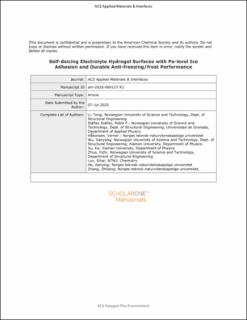| dc.contributor.author | Li, Tong | |
| dc.contributor.author | Ibáñez-Ibáñez, pablo | |
| dc.contributor.author | Håkonsen, Verner | |
| dc.contributor.author | Wu, Jianyang | |
| dc.contributor.author | Xu, Ke | |
| dc.contributor.author | Zhuo, Yizhi | |
| dc.contributor.author | Luo, Sihai | |
| dc.contributor.author | He, Jianying | |
| dc.contributor.author | Zhang, Zhiliang | |
| dc.date.accessioned | 2020-09-07T07:52:50Z | |
| dc.date.available | 2020-09-07T07:52:50Z | |
| dc.date.created | 2020-07-08T16:54:40Z | |
| dc.date.issued | 2020 | |
| dc.identifier.issn | 1944-8244 | |
| dc.identifier.uri | https://hdl.handle.net/11250/2676541 | |
| dc.description.abstract | Despite the remarkable advances in mitigating ice formation and accretion, however, no engineered anti-icing surfaces today can durably prevent frost formation, droplet freezing and ice accretion in an economical and eco-friendly way. Herein, sustainable and low-cost electrolyte hydrogel (EH) surfaces are developed by infusing salted water into the hydrogel matrix for avoiding icing. The EH surfaces can both prevent ice/frost formation for an extremely long time and reduce ice adhesion strength to ultralow value (Pa-level) at a tunable temperature window down to -48.4 oC. Furthermore, ice can self-removes from the tilted EH surface within 10 s at -10 oC by self-gravity. As demonstrated by both molecular dynamics simulations and experiments, these extreme performances are attributed to the diffusion of ions to the interface between EH and ice. The sustainable anti-icing properties of EH can be maintained by replenishing in real-time with available ion sources, indicating the promising applications in offshore platforms and ships. | en_US |
| dc.language.iso | eng | en_US |
| dc.publisher | American Chemical Society | en_US |
| dc.title | Self-deicing Electrolyte Hydrogel Surfaces with Pa-level Ice Adhesion and Durable Anti-freezing/frost Performance | en_US |
| dc.type | Peer reviewed | en_US |
| dc.type | Journal article | en_US |
| dc.description.version | acceptedVersion | en_US |
| dc.source.journal | ACS Applied Materials & Interfaces | en_US |
| dc.identifier.doi | 10.1021/acsami.0c06912 | |
| dc.identifier.cristin | 1818989 | |
| dc.relation.project | Norges forskningsråd: 255507 | en_US |
| dc.relation.project | Norges forskningsråd: 245963 | en_US |
| dc.description.localcode | Locked until 8.7.2021 due to copyright restrictions. This document is the Accepted Manuscript version of a Published Work that appeared in final form in [JournalTitle], copyright © American Chemical Society after peer review and technical editing by the publisher. To access the final edited and published work see https://doi.org/10.1021/acsami.0c06912 | en_US |
| cristin.ispublished | true | |
| cristin.fulltext | postprint | |
| cristin.qualitycode | 1 | |
